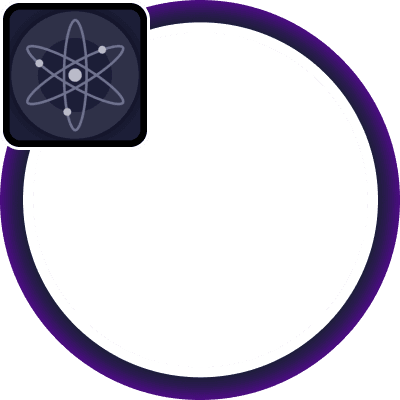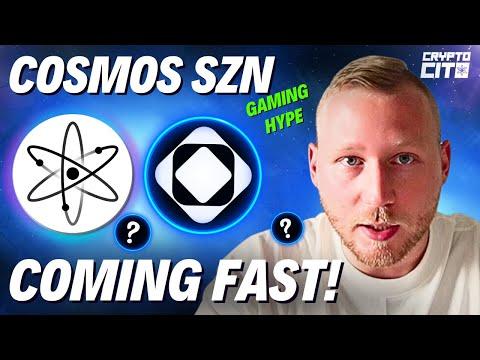Overview of Cosmos Hub
Launched in March 2019, Cosmos Hub emerged as a pivotal blockchain project, facilitating an era of blockchain interoperability and scalability. Born from a successful Initial Coin Offering (ICO) that raised $17 million, Cosmos Hub was developed by Jae Kwon and Ethan Buchman of Tendermint Inc., now known as Ignite. The project has significantly contributed to the blockchain space by hosting over 200 projects developed on the Cosmos SDK, demonstrating the SDK’s versatility and robustness across various applications, from decentralized finance (DeFi) platforms to blockchain-based games and social media platforms.
Technical Infrastructure
Tendermint/CometBFT
Initially, the Cosmos Hub was powered by the Tendermint Core consensus engine, renowned for its Byzantine Fault Tolerance (BFT) capabilities. In February 2023, a significant evolution occurred with the launch of CometBFT, a fork and successor to Tendermint Core. CometBFT now serves as the official state machine replication engine for the Cosmos Interchain ecosystem, embodying a strategic shift towards enhanced performance, security, and modularity in an IBC-native, multi-chain world.
CometBFT enhances the Cosmos Hub’s technical infrastructure with a focus on user-centric design, rigorous testing, and modularity. This consensus engine is tailored for large-scale, application-specific blockchains, aiming to be the primary choice for developers seeking reliability and flexibility. The transition to CometBFT was driven by a collaborative effort among the Interchain Foundation, Informal Systems, the Cosmos SDK team, and other key stakeholders in the Cosmos ecosystem. This change marks a pivotal development in the Cosmos project, aligning with the network’s evolution and the broader technical and administrative landscape.
Inter-Blockchain Communication (IBC)
A cornerstone of the Cosmos Hub’s technical infrastructure is the IBC protocol, enabling seamless interoperability and secure data and value exchange between independent blockchains. IBC facilitates a new paradigm of blockchain connectivity, allowing for diverse applications to interoperate efficiently within the Cosmos ecosystem. This protocol is instrumental in realizing the vision of an interconnected blockchain ecosystem, where each blockchain can leverage the strengths of others.
Cosmos SDK: A Developer’s Framework
The Cosmos SDK is pivotal to the Cosmos Hub’s infrastructure, enabling the creation of customizable and interoperable blockchains. Its modular architecture allows developers to easily build application-specific blockchains, leveraging pre-built modules for functionalities like governance and staking. Designed for scalability, it supports the Inter-Blockchain Communication (IBC) protocol, facilitating seamless interactions among blockchains within the Cosmos ecosystem. Emphasizing developer experience, the SDK offers extensive documentation and resources, making blockchain development accessible across different expertise levels. Primarily utilizing Golang, it combines simplicity and performance, fostering a vibrant community of developers and contributors. The Cosmos SDK is foundational in realizing the Cosmos vision of an interconnected blockchain universe, underscoring its importance in the ecosystem’s growth and innovation.
Hub Tokenomics
ATOM: The Native Token
ATOM serves as the primary currency within the Cosmos Hub and AEZ, essential for staking, paying transaction fees, and participating in the governance of the network. $ATOM is also accepted on almost every other IBC connected chain for gas payments, extending it’s role beyond not just it’s home chain, but even beyond the AEZ ecosystem. The introduction of CometBFT and the continuous evolution of the Cosmos SDK and IBC have significantly impacted ATOM’s utility and value proposition, positioning it as a key player in the interchain ecosystem.
Aside from staking & paying gas fees, other popular uses for the ATOM token include:
– Providing liquidity on DEX‘s throught the Interchain, such as Osmosis, Astrovault, White Whale, and many more.
– Lending as collateral for loans on lending & borrowing platforms such as Mars or UX chain.
– Being used to purchase NFTs on platforms like Omniflix and Stargaze.
– Depositing in single-sided, impermentant loss avoiding protocols, such as Thorchain’s saver vaults.
Economic Model and Distribution
The economic model and initial distribution of ATOM, the native token of the Cosmos Hub, are meticulously designed to incentivize network participation, ensure the long-term sustainability of the ecosystem, and maintain robust network security. This comprehensive approach underpins the decentralized governance and operational integrity of the Cosmos Hub.
Initial Distribution
During the Cosmos Hub’s Initial Coin Offering (ICO) in April 2017, $17,300,000 was raised at a rate of $0.1 per ATOM. The ICO offered up for sale 75% of the initial 236,173,406 ATOMs that were created at genesis.
The overall distribution of genesis tokens is a bit unclear, but looks something like this:
- ICO Participants: 75 of the initial ATOM supply was allocated to investors in the ICO, promoting wide distribution for decentralized network ownership.
- ICF: 10% was earmarked for “The Cosmos Network Foundation,” now known as the Interchain Foundation (ICF,) to fund ongoing development, research, and community initiatives crucial for the ecosystem’s growth.
- All-in-Bits: In addition to the ICF, All-In-Bits (AIB) received 10% for their contributions to core pieces of infrastructure like the TendermintBFT, IBC, and more.
- Early Contributors/Advisors/Lead Donors: This group of individuals, integral to the project’s early phase, received a share for their expertise, guidance, and support; totaling 5% spread amongst them.
Economic Mechanisms and Inflation
The Cosmos Hub employs a Proof-of-Stake (PoS) consensus mechanism, where ATOM holders stake their tokens with validators. This process secures the network and grants stakers governance rights and rewards, aligning incentives across the ecosystem.
-
Inflationary Reward Model: To compensate validators and delegators for securing the network, new ATOMs are minted as rewards. The inflation rate is dynamically adjusted to maintain a target staking ratio, ensuring network security while managing inflation to protect ATOM’s value. This model balances incentivizing participation with economic sustainability.
-
Dynamic Inflation: The inflation rate varies based on the total percentage of ATOM staked, with a mechanism to adjust inflation to encourage a desired level of network participation. This flexible approach ensures that the network remains secure and validators are adequately compensated for their efforts.
-
Governance Participation: ATOM holders actively participate in governance decisions, including protocol changes and community fund allocations, ensuring the network evolves in line with community interests.
Long-term Sustainability
The Cosmos Hub’s economic model is crafted for resilience and adaptability, encouraging active governance participation and staking for network security. As the Cosmos ecosystem expands, the model’s parameters, including token distribution and inflation mechanisms, can be adjusted through governance proposals, reflecting the community’s evolving needs and priorities.
Atom Economic Zone (AEZ)
The Atom Economic Zone (AEZ) and Interchain Security are key strategic initiatives designed to expand and secure the Cosmos ecosystem. These concepts introduce a framework for fostering a cooperative network of blockchains that can benefit from shared security mechanisms while maintaining their sovereignty.
Interchain Security
This allows validators of the Cosmos Hub to secure multiple chains simultaneously. The security model is innovative because it extends the robust security framework of the Cosmos Hub to smaller, emerging blockchains, which may not have the resources to establish such a secure environment independently. This shared security model is pivotal for the ecosystem’s growth, ensuring that emerging projects can benefit from the same level of security as the Cosmos Hub.
Consumer Chains
Validators participating in the Interchain Security mechanism are incentivized through additional rewards, which may include the native tokens of the Consumer Chains they help secure. This not only enhances the security of the entire ecosystem but also provides validators with a diversified stream of income, encouraging their participation and investment in the ecosystem’s security.
Wallet Support and Ecosystem Participation
Support for ATOM spans several reputable wallets, offering secure storage and management solutions. Wallets like Keplr, Cosmostation, Leap, and Ledger cater to various user preferences, from multi-chain wallets to hardware wallets, ensuring user access to secure and convenient interaction with the Cosmos ecosystem.
Participation and Staking Rewards
Participating in the Cosmos Hub through staking is a key mechanism for securing the network and earning rewards.
- Staking APR: The Annual Percentage Rate (APR) for staking ATOM can vary widely based on network conditions and the inflation rate. Historically, staking rewards have ranged from approximately 8% to 15% APR. As of 2/16/2024 the staking APR is 13.77%. These rewards compensate validators and delegators for their participation and the risks associated with securing the network, such as the potential for slashing in the event of misbehavior.
- Slashing Conditions: To maintain network integrity, validators are subject to slashing if they fail to meet operational standards. This includes being offline for extended periods or double-signing transactions. The specific penalties can vary, but examples include a 0.01% penalty for downtime and a more severe penalty for double-signing, which can be up to 5% of the staked ATOM and removal from the validator set.
Risks and Rewards
While staking ATOM secures the network and offers rewards, it also introduces risks such as slashing for validators that behave maliciously or fail to maintain operational standards. Understanding these dynamics is essential for participants aiming to engage with the Cosmos Hub effectively.
Governance and Future Developments
Governance in the Cosmos Hub is a critical component, allowing the community to steer the development and major decisions of the network.
- Voting Power: ATOM holders have the ability to vote on various proposals, which can include changes to the network protocol, updates to the governance process, and allocation of community funds. The influence of a participant’s vote is proportional to the amount of ATOM they have staked.
- Proposal Process: Proposals go through several stages, including a deposit period where a minimum amount of ATOM must be locked up to demonstrate serious intent, followed by a voting period where all staked ATOM holders can cast their vote. The criteria for a proposal to pass include achieving a quorum, a majority of “Yes” votes, and not exceeding a threshold of “NoWithVeto” votes.
History, Timeline, and Notable Events
The history of the Cosmos Hub, an innovative blockchain network designed for interoperability and scalability, is a testament to the ambitious vision of creating a decentralized internet of blockchains. This section provides a detailed chronology of the Cosmos Hub, from its conceptualization to its current state in 2024.
Prelude to Launch (2014-2019)
-
2014: Development of Tendermint
-
2015: Ethan Buchman Joins the Team
- Ethan Buchman joined Jae Kwon, bringing additional expertise to the development of Tendermint. Their collaboration led to significant advancements, setting the stage for the Cosmos Network.
-
2016: Cosmos Whitepaper and Recognition
- The Cosmos Whitepaper, “A Network of Distributed Ledgers,” was published, introducing the vision for a scalable and interoperable blockchain network. Cosmos won the “Most Innovative Project” award at Shanghai Blockchain Week, highlighting its groundbreaking approach.
-
2017: Cosmos ICO and SDK Development
- The Cosmos ICO raised ~$17 million in about 30 minutes, demonstrating strong community and investor belief in the project. Development of the Cosmos SDK also began, offering a flexible framework for building blockchain applications.
-
2018: Introduction of IBC and Testnets
- The concept of Inter-Blockchain Communication (IBC) was introduced, and over 20 public testnets were launched by Cosmos validators, culminating in the “Game of Stakes,” a testnet that showcased the robustness of the Tendermint consensus mechanism.
-
2019: Cosmos Hub Launch
- March 13, 2019: The Cosmos Hub officially launched, marking a significant milestone in the blockchain space. Binance also announced Binance Chain, built on Tendermint BFT and the Cosmos SDK, showcasing the technology’s real-world application and adoption.
Genesis and Growth (2019-Present)
-
2019: IBC Development and Ecosystem Growth
- Post-launch, the Cosmos Hub focused on the development of the Inter-Blockchain Communication (IBC) protocol, enabling seamless interoperability between different blockchains. The Cosmos SDK became a vital tool for developers, fostering a growing ecosystem of applications.
-
2020: Gravity Bridge and Community Growth
- The Cosmos community was bolstered by the creation of the Interchain Foundation, supporting network development. The “Gravity Bridge” upgrade facilitated asset transfers across blockchains, expanding the network’s capabilities.
-
2021: Stargate Upgrade and IBC Launch
- February 2021: The Cosmos Hub underwent the Stargate upgrade, which activated the IBC protocol on the mainnet, allowing cross-chain communication. The “Game of Zones” competition showcased the network’s resilience and scalability.
-
2022: Interchain Security Proposal
- October 2022: The Cosmos Hub community proposed the Interchain Security feature, which allowed the Cosmos Hub to secure other blockchains in the ecosystem, establishing its role as a central hub for security and governance.
-
2023: Interchain Security Activation and Liquid Staking
- February 2023: Interchain Security was activated, enabling the Cosmos Hub to provide security to other chains.
- August 2023: Liquid staking was introduced on the Cosmos Hub, allowing users to stake their ATOM tokens while still being able to use them in DeFi protocols.
-
2024: Atom Economic Zone (AEZ) Launch and ATOM 2.0
- January 2024: The ATOM 2.0 proposal was introduced, bringing new mechanisms for tokenomics and governance specific to the Cosmos Hub.
- March 2024: The Atom Economic Zone (AEZ) was launched, creating an ATOM-aligned ecosystem of chains and dApps secured by the Cosmos Hub’s validator set, enhancing the utility and economic value of ATOM.
- May 2024: ATOM 2.0 was implemented, introducing enhanced governance and staking mechanisms.
- August 14, 2024: The Cosmos Hub solidified its position as the leading interchain ecosystem, with over $10 billion in TVL and the highest number of interconnected blockchains.










